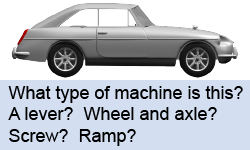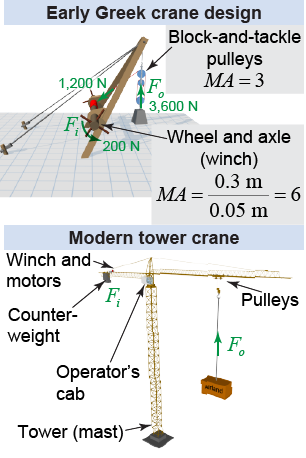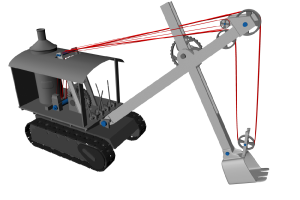|
 It is not surprising that a car is a machine. But what kind of machine is a car? Is it a lever? Does it contain a wheel and axle? A better question to ask is this: What types of machines does it contain? A car is a compound machine, which means that it is made up of two or more simple machines that work together in order to accomplish its tasks.
It is not surprising that a car is a machine. But what kind of machine is a car? Is it a lever? Does it contain a wheel and axle? A better question to ask is this: What types of machines does it contain? A car is a compound machine, which means that it is made up of two or more simple machines that work together in order to accomplish its tasks. 
|
Combining more than one machine
|
Earlier in this chapter you worked with a compound machine, although you might not have realized it! The block and tackle is a compound machine made up of two or more pulleys connected together. A compound machine is a combination of two or more simple machines that work together to accomplish a task. 
|
 The crane was an important machine developed during the classical period and used to construct the Parthenon and other ancient monuments. With a modest-sized device, one man could lift an object that would normally require the strength of several men—and he could do so with a more convenient posture! One early crane design developed by the Greeks was the trispastos, which was made up of two simple machines: the pulley and the wheel and axle. This design was later enhanced by Roman engineers and was used extensively across the Roman Empire.
The crane was an important machine developed during the classical period and used to construct the Parthenon and other ancient monuments. With a modest-sized device, one man could lift an object that would normally require the strength of several men—and he could do so with a more convenient posture! One early crane design developed by the Greeks was the trispastos, which was made up of two simple machines: the pulley and the wheel and axle. This design was later enhanced by Roman engineers and was used extensively across the Roman Empire.
The block and tackle contained three pulleys (the origin of the prefix “tri” in trispastos), which had a combined mechanical advantage of 3. The user turned a winch, which is a form of the wheel and axle and might have had a mechanical advantage of around 6. By combining these two simple machines together into the crane, a mechanical advantage of 18 was achieved! 
|
Modern tower cranes use these same principles: An electric motor drives the winch and a series of pulleys multiply the force above the object being lifted. These cranes are used to lift heavy materials to the top of a building under construction. They are also used in ports to load containers onto ships. To avoid tipping over when lifting such heavy loads, a tower crane must employ a counterweight on the opposite side. 
|
A compound machine is made up of two or more simple machines that vary the forces applied. The individual mechanical advantages of each of those simple machines are multiplied together to determine the mechanical advantage of the compound machine. To determine the mechanical advantage of the Greek crane design in the illustration above, just multiply the individual mechanical advantages: MApulleys×MAwinch = 3×6 = 18! 
|
 The steam shovel is a piece of heavy machinery that was the precursor to modern-day front-end loaders. It was used to scoop up dirt and stones to dig holes or trenches. How many simple machines can you identify in its scooping mechanism?
The steam shovel is a piece of heavy machinery that was the precursor to modern-day front-end loaders. It was used to scoop up dirt and stones to dig holes or trenches. How many simple machines can you identify in its scooping mechanism?
 |
There are two levers: one connected to the cab and the other connected to the shovel. Each lever is raised or lowered using its own block-and-tackle system—although one set of pulleys is hidden from view! 
|

